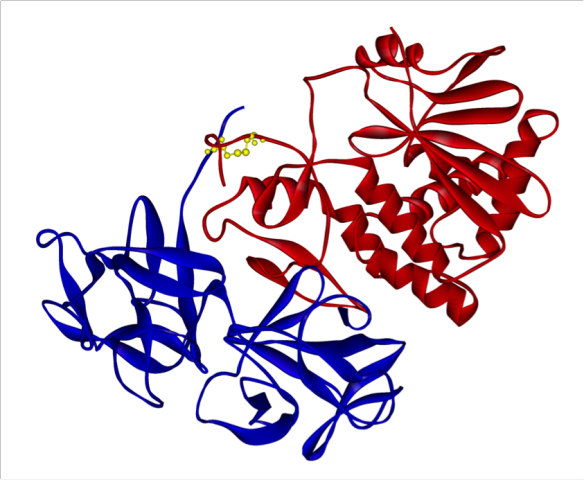Possibly the Deadliest Crystal Structure Known: Ricin
What does it look like?

Ricin from Ricinus communis with A chain in red and B chain in blue and linking disulphide bond in yellow.
What is it?
Ricin could possibly be one of the most deadly toxins known. It only requires one ricin molecule to kill a cell. It is produced in the seeds of the castor oil plant Ricinus communis, which is very common, particularly in the Mediterranean and tropical areas. The castor oil plant is cultivated for its seeds, which are the source of castor oil, and eating anywhere from 4 to 20 of the seeds could prove to be fatal. In its purified form, 1.78 milligrams of ricin is enough to kill an average sized adult through injection or inhalation (ricin is less effective if taken orally).
Ricin is a protein known as a lectin, which means it binds to carbohydrates, giving us a clue as to how ricin works. Ricin consists of two protein chains (A and B) linked by a disulphide bond (the part coloured yellow). The B chain (the chain coloured blue in the image) binds to carbohydrates on the surface of the cell membrane allowing the ricin molecule to be internalised into the cell. Once ricin is inside the cytoplasm of the cell the disulphide bond is broken, realising the A chain (red). The A chain carries out the deadly functions by breaking down the protein factories inside the cell known as ribosomes (see here for the earlier blog on the ribosome crystal structure) and thus inhibiting protein synthesis.
Ricin is notorious due to its potential to be turned into to a biological weapon. But thankfully, ricin, although relatively easy to obtain, is difficult to turn into a weapon due to the difficultly in turning it into an aerosol and difficulty in storing. However, in 1978 during the cold war Bulgarian writer Georgi Markov was killed in London by a ricin filled pellet fired from the tip of an umbrella. On a more cheerful note ricin also has many potential therapeutic applications. Ricin has been used to create immunotoxins. This is where the ricin molecule has been linked to an antibody so that the potent activity of ricin can be delivered to specifically kill cancer cells.
Where does it come from?
The structure of ricin was solved by Earl Rutenber and colleagues in 1991 [1] and has the PDB number 2AAI in the Protein Data Bank.
[1] E. Rutenber, B. J. Katzin, S. Ernst, E. J. Collins, D. Mlsna, M. P. Ready, J. D. Robertus (1991) Crystallographic Refinement of Ricin to 2.5 Å. Proteins 10: 240 – 250.






